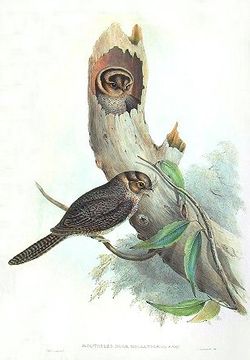|
Owlet-nightjar |

|
|
Scientific classification |
| Kingdom: |
Animalia
|
| Phylum: |
Chordata
|
| Class: |
Aves
|
| Order: |
Caprimulgiformes
|
| Family: |
Aegothelidae
|
| Genus: |
Aegotheles
Vigors and Horsfield, 1827 |
|
Owlet-nightjars are small
nocturnal
birds related to the
nightjars and
frogmouths. Most are native to New Guinea, but some species
extend to Australia, the Moluccas, and New Caledonia.
Owlet-nightjars are
insectivores which hunt mostly in the air but sometimes
on the ground; their soft plumage is a crypic mixture of
browns and paler shades, they have fairly small, weak feet
(but larger and stronger than those of a frogmouth or a
nightjar), a tiny bill that opens extraordinarily wide,
surrounded by prominent whiskers. The wings are short, with
10 primaries and about 11 secondaries; the tail long and
rounded.
Systematics
The comprehensive 2003 study by Dumbacher et al.
analyzing mtDNA sequences Cytochrome b and ATPase subunit 8
suggests that 11 species of owlet-nightjar should be
recognized, plus one that went extinct early in the second
millennium AD.
The relationship between the owlet-nightjars and other
groups within the
Caprimulgiformes has long been controversial and obscure and
remains so today: in the 19th century they were regarded as
a subfamily of the frogmouths, and they are still generally considered to
be related to the frogmouths and/or the
nightjars but there have also been recent suggestions (Mayr,
2002) that they are not so closely related to either as
previously thought, and that the owlet-nightjars share a
common ancestor with the
Apodiformes.
In form and habits, however, they are very similar to
both caprimulgiform group - or, at first glance, to small
owls
with huge eyes. Interestingly, the ancestors of the
swifts and
hummingbirds, two groups of birds which are
morphologically very specialized, seem to have looked very
similar to a small owlet-nightjar, possessing strong legs
and a wide gape, while the legs and feet are very reduced in
today's swifts and hummingbirds, and the bill is narrow in
the latter.
They were thought to have originated in
Australasia or Southeast Asia, but the recent discovery of
owlet-nightjar fossils in France dating back to the
Oligocene
suggests otherwise.
- Genus Quipollornis (fossil;
Early/Middle Miocene of New South Wales)
- Genus Aegotheles
- New Zealand Owlet-nightjar, Aegotheles
novaezealandiae (prehistoric; formerly Megaegotheles)
New Caledonian Owlet-nightjar, Aegotheles savesi
Feline Owlet-nightjar, Aegotheles insignis
Starry or Spangled Owlet-nightjar, Aegotheles tatei
Moluccan or Long-whiskered Owlet-nightjar,
Aegotheles crinifrons
Australian Owlet-nightjar, Aegotheles cristatus
Barred Owlet-nightjar, Aegotheles bennettii
Upland Barred Owlet-nightjar, Aegotheles affinis
(formerly A. bennettii affinis
Salvadori's Owlet-nightjar, Aegotheles salvadorii
(formerly A. albertisi salvadorii)
Wallace's Owlet-nightjar, Aegotheles wallacii
Archbold's Owlet-nightjar, Aegotheles archboldi
Mountain Owlet-nightjar, Aegotheles albertisi
References
- Dumbacher, John P. ; Pratt, Thane K. &
Fleischer, Robert C. (2003): Phylogeny of the
owlet-nightjars (Aves: Aegothelidae) based on
mitochondrial DNA sequence. Molecular Phylogenetics
and Evolution 29(3): 540–549.
DOI:10.1016/S1055-7903(03)00135-0
PDF fulltext
- Mayr, Gerald (2002): Osteological evidence
for paraphyly of the avian order Caprimulgiformes
(nightjars and allies). Journal für Ornithologie
143: 82–97.
PDF fulltext




